How To Choose a Template for Your Website
We may receive a commission from our partners if you click on a link and purchase a product or service on their website. Learn more
Choosing a template for your website is often the first step when you get set up with a website builder. But with hundreds of free website templates, premium designs, and AI website builders available, it’s tough to know where to start or how to choose the right template for your business and audience.
From understanding the purpose of your website to customization options and template costs, I’ll walk you through everything you need to know about choosing a beautiful and functional website template.

Key Takeaways 🔍
- Website builders can offer free and premium templates (Wix’s 2,000+ templates are free to all users)
- Consider design best practices, such as accessibility and navigation, when choosing a template
- Make sure your chosen template can be optimized for mobile devices
- To keep your website running smoothly, avoid cluttered designs or templates with lots of code
- You can customize your template using your builder’s editor
7 Factors To Consider When Choosing Your Template
When choosing a template, consider your business and audience’s needs, as well as the optimization opportunities, customizability, included features, and cost of the template. While this may sound like a lot to consider, I’m going to break it down into seven simple questions:
- What’s the purpose of your website?
- Have you researched your audience?
- Is the template mobile responsive?
- Are there built-in SEO optimizations?
- Do you need specific template features?
- Can you customize the template?
- Does the template fit your budget?
For this guide, I’ll be using Wix as an example. Of our favorite five website builders from our 2025 testing, not only is Wix our top recommendation, but it also offers the highest number of templates. With Wix, you can choose from over 2,000 free website templates, professionally designed for a wide range of industries and website types.
1. What’s the Purpose of Your Website?
It’s nearly impossible to find the perfect template for your business because you’ll always want to put your own stamp on things. Because of this, it’s best to pick a template that closely aligns with your business type, industry, and brand personality. This will save you time during the customization stage. Think about:
- Your business goals
- The user journey
- Your existing brand assets
For example, an ecommerce template will already be equipped with useful elements for an online store, such as a contact form and shop page. A blogging template will focus primarily on your content, and a template for a portfolio website will have a heavy emphasis on visuals and unique ways to display work.
If your business has a very professional brand image, find something that’s simple and minimal. A trendy template won’t be the best match for you. However, if you’re looking to build an art portfolio website, you might want something more creative and playful to match your style. You shouldn’t need to adapt your business to match the template.
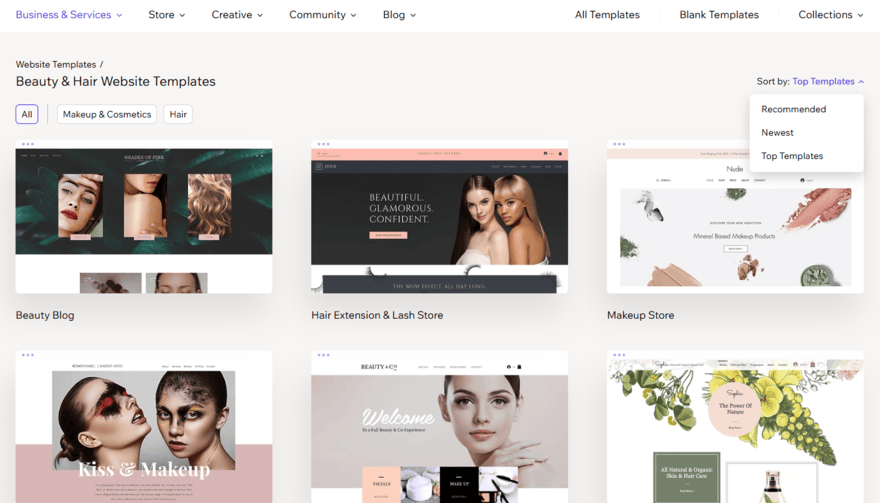
Top Tip 💡
Wix lets you filter its template library for specific industries, making it easier to find a match. During my tests, I could browse all 2,000+ free templates at once, or select one of the 102 unique categories to find a specific theme. I could also filter these categories to see the top options for each industry. The broader filters include categories such as “Health & Wellness,” “Professional CV,” and “Communities.”You can preview templates before you start editing, and Wix provides a helpful description of recommended business types for each. I always recommend previewing and exploring your template fully before committing to it, so don’t skip out on this handy feature.
2. Have You Researched Your Audience?
While it’s essential to consider your business needs when selecting a template, it must also cater to your audience. After all, they’ll be the ones spending time on your website.
Do your research before selecting your website template. While you may personally love the green design of your website, your target audience might not. I recommend:
- Getting feedback from your existing customers about the user journey and your site’s navigation (if you don’t have a website yet, you can ask your target audience about the websites they use and what they like or dislike about them)
- Checking the accessibility of your chosen template – for example, is the text easy to read? Are the pages structured well already? Can you add alt text to the images?
- Assessing analytics and data to see if certain pages or designs trigger higher bounce rates
- Focusing on the desired action you want visitors to take, such as buying a product or signing up for a newsletter, and ensuring your template is equipped to direct users towards this
3. Is the Template Mobile Responsive?
All of Wix’s 2,000+ templates are optimized for mobile, meaning your site’s design and content will be automatically adjusted for different device screens. You can toggle to test the mobile view when choosing a template initially, or when you’re in Wix’s editor.
According to Exploding Topics, over 64% of all website traffic in 2025 comes from phones, so your template must be able to adapt to these devices, or you risk missing out on engagement and sales.
Given its importance, most templates across the market will be very responsive, so it shouldn’t be hard to find a template that works for mobile devices. However, if a template doesn’t support mobile optimization, avoid picking it for your website.

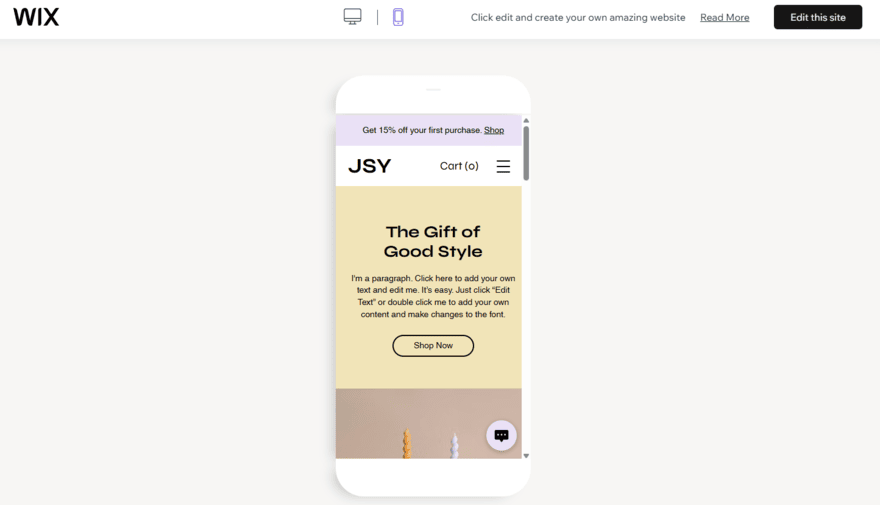
4. Are There Built-In SEO Optimizations?
Your template plays a big role in how your site performs from an SEO standpoint. A messy, slow-to-load, and badly-coded template can impact your website’s rankings on Google and the overall user experience. In comparison, a fast, clean, and well-optimized template can boost your site’s visibility and reputation online.
There are a few things to look out for if you want an SEO-friendly template:
✅ What to look for
- Well-structured pages – this makes it easier for search engines and visitors to navigate
- Headings to break up content (avoid walls of text!)
- Clean designs that aren’t bogged down with heavy code to help your website run smoothly and quickly
- Metadata and schema markup support
- Mobile optimization
❌ What to avoid
- Cluttered templates with lots of elements (this can add a lot of code to your site and slow things down)
- Unclear messaging – if your template design doesn’t match your business and brand identity, you’ll confuse search engines and visitors
5. Do You Need Specific Template Features?
Depending on your target audience and the purpose of your website, you might be after specific features when choosing a template. A small business might want product pages and elements showcasing customer reviews – if you pick a template with these features already built in, you save yourself time from the start.
Thankfully, you can filter Wix’s template library to find a theme that caters to your specific industry – additional filters can then be applied to see the top options. These will have elements, sections, and functionality to support your goals, but everything can be customized in the editor.
For example, Wix’s “Home Remodeling Company” template (a top template for the construction industry) includes call-to-action buttons, elements showcasing offered services, testimonials, trust seals, a contact form, and more.
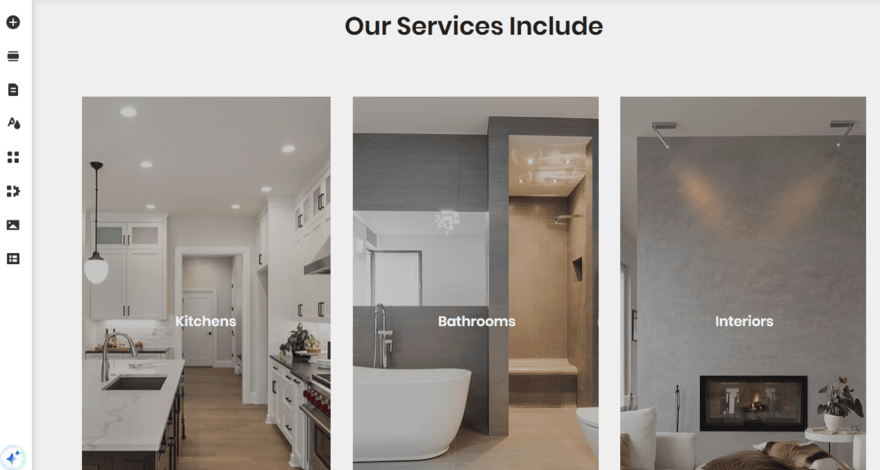
6. Can You Customize the Template?
I highly recommend making changes to your chosen template before publishing, whether that’s immediately or at a later date.
If you’re short on time, pick a low-effort template that won’t need many changes. But, if you’re not in a rush and you pick a builder with an easy-to-use editor, your chosen template doesn’t have to match your vision that closely, since you can customize it to suit your needs.
Here are a few reasons why Wix’s editor is great for customizing templates:
- Wix’s drag-and-drop editor gives you total creative control
- Wix provides AI tools to help you generate text, images, and new sections
- You don’t need any coding knowledge (but advanced customization is available)
- Wix gives you the option to preview your template for desktop and mobile devices
- Wix automatically saves your edits
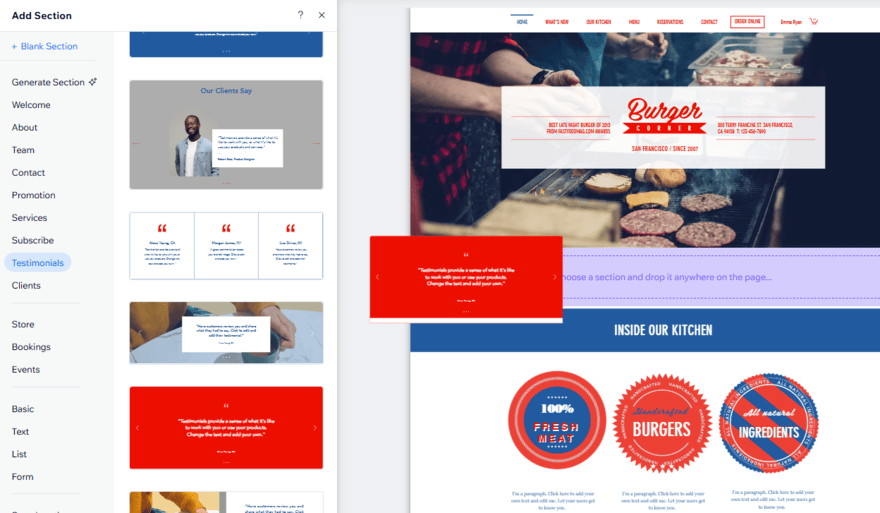
One of Wix’s AI features, the AI Theme Assistant, offers personalized recommendations to help you customize elements like your template’s color scheme or font type. A tool like this helps you follow website design best practices and makes the whole process less daunting once you’ve chosen your website template.
Did You Know? 💭
With Wix, you can’t switch to a different template once your website is live. So, keep this in mind when choosing your site template at the start, and focus on the overall layout and structure to ensure they suit your business and audience. Don’t get caught up in the details – design tweaks can be made in Wix’s editor at any time.7. Does the Template Fit Your Budget?
Some website builders offer a mix of free templates and premium options, with one-time price tags reaching up to $500. For those who aren’t looking to splurge on a template, all of Wix’s templates are free to use.
For small businesses and personal sites, Wix’s no-cost templates offer a great starting point, especially for those on a budget. It’s not always possible to hire a professional web designer or spend money on courses to learn how to code yourself.
By choosing a high-quality free template, you don’t have to break the bank to design your website.
Should You Build a Template With AI Instead?
If you’re struggling to choose a template that suits your brand and business needs, consider designing your own with the help of AI.
When you choose a pre-built template, there’s a risk that someone else will be using the same one. Of course, you can make customizations and design tweaks to put your own stamp on it, but it can be harder to stand out from the crowd.
That’s where AI comes in. Wix’s AI website builder will ask a few questions about your website needs before generating a custom template for you. The whole process takes less than 10 minutes, and at the end, you’ll get a unique design that fits your specific business requirements.

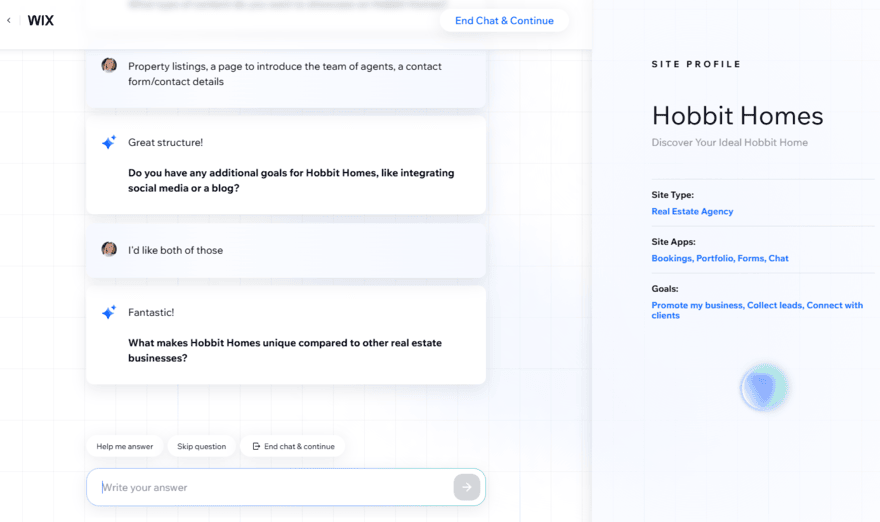
Are You Ready To Choose a Template for Your Website?
Knowing how to choose a website template isn’t rocket science, but you do need to consider factors like your website’s purpose, your audience, customization options, mobile-friendliness, and more.
Your website template sets the tone for your business, delivering a first impression for new visitors that needs to match your branding and vision. As discussed, choose the template that matches your needs the closest, and make any edits you need in the editor before publishing. Plus, you can continue to make tweaks to your website at any time, so it’s not now or never.
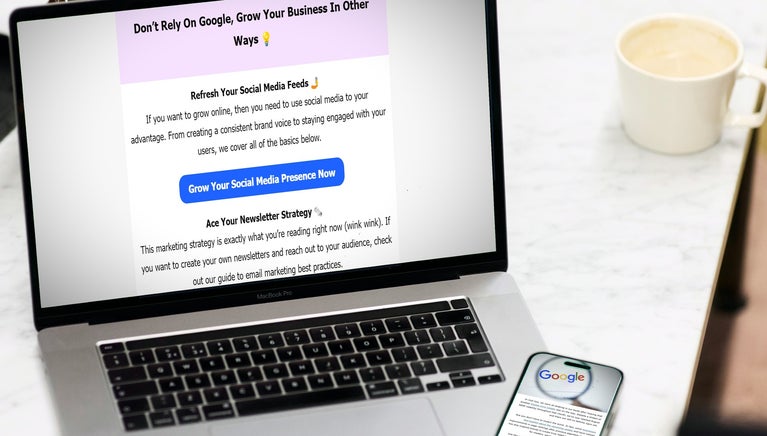
Leave a comment